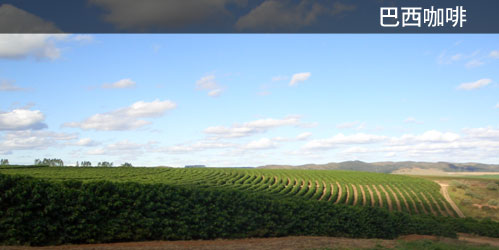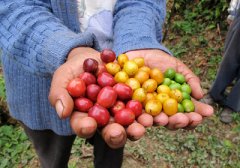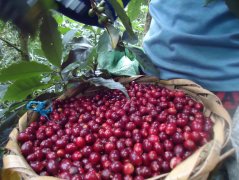Brazilian coffee culture background Brazilian coffee beans growing environment processing process hand-made Brazilian coffee

Professional coffee knowledge exchange More coffee bean information Please pay attention to coffee workshop (Weixin Official Accounts cafe_style)
Brazilian coffee culture
I. Cultural characteristics
Coffee gives people the feeling that it is an elegant and noble drink, and its rich aroma is even more fascinating. Coffee used to be a luxury drink, but now it has become a popular leisure or afternoon tea drink, and even coffee is made into a variety of snacks, which makes people love it. Where is the charm of coffee? How is it grown?
When it comes to coffee, we can easily associate it with some countries with hot climates, such as Central and South America, Southeast Asia, Africa, etc. Although the cultivation is called coffee, but according to its soil, rainfall, temperature, terrain, taste is divided into many kinds, here we are introducing is Brazilian coffee.
<1> Growing environment
Coffee grows mostly in sunny (conducive to coffee bean harvest), rainy (annual rainfall of about 1000-1250 mm) and rarely frosted (because frost will kill coffee trees), while well-drained gentle hillside and deep, fertile red soil or weathered soil are conducive to coffee growth.
Coffee is grown mostly on high-altitude plateaus or hillsides, gravelly sandy soil, but Brazil's terrain is relatively flat. To adapt to local conditions, scientists have studied another cultivation method that allows it to grow on lower terrain, which is different from the traditional high-altitude cultivation method with proper shade.
Brazil's coffee garden is located at a lower altitude, is directly exposed to the sun growth, so that coffee can grow faster, but its taste has not yet fully developed, so the beans are less solid, low acidity has a woody taste, suitable for mixing with other coffee.
<2> Coffee processing
Now we drink coffee, in fact, through a lot of procedures to complete, and the general harvest of coffee beans to our drink alcohol coffee is through a number of procedures, the steps are as follows:
1. Harvesting: The harvesting of coffee fruits depends on manual processing, one by one picked from trees.
2. Processing: There are two ways to process coffee fruit
I. Solarization method: spread on the ground for about 12--15, direct exposure, drying directly after the pulp, to the bean shell, the kernel is less complete, taste is poor, encounter rain due to fermentation easy to have miscellaneous taste, but the cost is lower.
II. Washing method: It is a more advanced method, only 20--24 hours, after fermentation, the pulp becomes shelled (drum beans), and after drying, the bean shell becomes clean green bean kernel, clean and odorless, fresh and mellow, the required time is short, the beans are complete, the bad beans are few, and the cost is high.
3. Roasting: After roasting, the color of coffee beans changes from green to coffee, and the aroma of coffee is also stimulated. Coffee beans from different origins are roasted to different degrees to match the needs of different uses.
4. Blending: After roasting coffee beans, in addition to single coffee, we will blend all kinds of single coffee into a variety of different flavors according to their characteristics, in proportion to meet the needs of different tastes and different brewing methods.
5. Grind: According to different cooking methods, grind to the appropriate thickness.
<3> Characteristics of Brazilian Coffee
Brazilian coffee is grown in low-altitude places, poor physique and disease resistance, taste has obvious nucleic acid flavor elegant, with dry processing method, its aroma taste moderate.
The coffee in Monchion de la Petite Jerry uses the traditional Brazilian 100% sun treatment. The direct effect on flavor is a very comfortable, smooth, non-disturbing fermentation flavor. It is perfect for espresso. Brazilian coffee is generally not very acidic, and even if it has good fruit acids, it is usually bland. St. Laurent round bean coffee shows delicious acidity under light roasting, with a pleasant sweet, light stone fruit flavor. Although it was sun-treated coffee, it tasted clean and had no unpleasant odors.
Brazilian coffee is generally considered to be bland and mild in taste, with coffee beans with obvious stone fruit flavor, dense consistency, low acidity and pleasant sweetness. It is the best choice for blending other coffees. Because of the government's industrial policy, the coffee produced in Brazil is of average quality, but there are not many excellent grades. One of the most famous is Santos coffee, mainly produced in Sao Paulo state, because the variety is Coffee Arabica Bourbon, so also known as Bourbon Santos, its taste is round, neutral, with a moderate amount of acid, can be boiled directly or mixed with other types of coffee beans to make a comprehensive coffee.
II. Cultural Background
<1> Brazil <
Brazil's official name is Federative_Republic_of_Brazil, and its political system is the Federal Republic. After many moves, the capital is currently located in Brasilia. The country is divided into 21 states, 4 regions and a special federal district Brasilia.
It has a population of about 155 million, ranking sixth in the world in 1990, but because of its vast territory, the average population density is not high. But more than two-thirds of the population lives on the coast and in large cities. Most of the population is descended from Portugal intermarriage with Indians or Africans. After the arrival of the Portugal in Brazil, the Indian population decreased significantly, leaving only 200,000 people, mostly distributed in the Amazon basin.
Portugal is the official language because it was colonized by Portugal. However, Portugal in Brazil differs greatly from its birthplace because of the influence of Indian and African languages. Some place names, plant and animal names have also been extended to African languages. It is worth mentioning that although Portuguese and Spanish look similar, there are great differences in pronunciation, but most Brazilians understand Spanish; English is less popular.
With an area of 8.51 million square kilometers, almost half the total area of South America and 236 times the size of Taiwan, it is the fifth largest country in the world, after Canada, Soviet Russia, China and the United States. Terrain to plateau and plains dominated, plateau area accounted for about half of the country: Guyana plateau in the north, east for the Brazilian plateau. The Brazilian Plateau is the largest plateau in the world, low in the north and high in the south. To the east, the Brazilian Plateau is the coastal plain, which is also the most densely populated area. In addition, between the Guyana Plateau and the Brazilian Plateau is the vast Amazon Plain, accounting for one third of the country's area.
Due to its vast territory, Brazil has a diverse climate. The equator passes through the north and the Tropic of Cancer runs through the south, so Brazil's climate is roughly divided into three climatic zones: tropical, subtropical and temperate. The central highlands in the south have a cool temperate climate; the equatorial rainforest climate is mainly distributed in the Amazon River basin in the north and north-central regions; and the narrow coastal plains in the northeast region have a subtropical climate. In addition, the north-eastern inland Sertao area is a semi-dry climate zone, because the rainy season is uneven, prone to heavy rain and periodic drought. The overall climate, except Rio de Janeiro south of winter (June-August) will be affected by cold temperatures lower, occasional snow, the rest of the region is like spring, cool and pleasant climate, summer from October to March is rainy season, but easy to thunderstorm (hot thunderstorm) throughout the year.
<2> The world's largest coffee producer
Coffee originated in Africa and was introduced to Brazil from Arabia in 1720. Coffee was cultivated since then, replacing sugar as Brazil's main export in the 19th century. Although Brazil has more frequent natural disasters than other coffee producing areas, its vast planting area is enough to make up for this natural disadvantage. Now it has become the world's largest coffee origin (Colombia and Vietnam are the second in order). Coffee of various grades and types accounts for one third of the world's total (three quarters of the world's total when the production is maximum), and it has a very important position in the global coffee trading market. Brazil's coffee industry adopts a price strategy, that is, exports at a low price and grows a large number of plants, with an annual output of about 2.6 million tons. As Brazil has been greatly affected by overproduction, the output will be limited by international coffee agreements. In addition, in Brazil, the variety, cultivated area and export volume of coffee are all dominated by the government. Because coffee exports are still Brazil's largest economic source, the Brazilian government has actively promoted coffee modernization in recent years. Its strategies include: To improve the quality of coffee, increase the yield per unit area, introduce new varieties, use more perfect tree species management method and modern processing equipment, so today Brazil coffee has been processed for export (such as instant coffee).
Brazilian coffee is mainly grown north of Parana to Minas, but most of the better quality coffee beans are concentrated in Bahia and Minas Greais, also known as Sul de Minas.
Brazilian coffee Generally speaking, Brazilian coffee tastes mild and bland, and it presents different tastes due to their different growing environment, processing methods and methods. Some have excellent caffeine exposure and washing processes, some have distinct stone fruit flavors and intense aromas, and some even have sweetness, making them ideal for espresso.
Brazil is famous for its mild taste, although not the best in the world, thanks to its government's industrial policies and the country's cheap products.
Comparison of coffee in different places
Coffee from Taiwan
Taiwan is on the Tropic of Cancer, with a mild climate and abundant rainfall and many high mountains, which is a very suitable place for coffee growth. In 1884, the British introduced it for trial planting in Taipei Three Gorges. During the Japanese occupation period, the Japanese saw that Taiwan's climate and soil were suitable for coffee, so they introduced "Arabica" from abroad. The trial planting was successful in the north, and a large amount of investment was made in planting rich yields in Zhiben and Mizuho. Taiwan's largest coffee production is located in the mountainous areas near Chiayi and Yunlin. Due to the high altitude of the mountainous areas and the temperature difference between day and night of more than 10 degrees, the coffee beans produced are also of the best quality. The fruits are full, the flesh is plump, the taste is sweet and mellow, and the taste is sweet, not astringent, not bitter, and not sour. It presents the delicious coffee.
2 Kenya
Kenyan coffee is unique in that it has a distinct fruity sweetness and sourness. Many people are afraid of drinking sour coffee. Sour coffee is a common feeling of many people to Kenyan coffee. Because Kenya coffee mostly comes from small coffee farmers, planted in a variety of different environments, each year encounters different climate, rainfall, so there is a clear fruit acid, bringing a variety of distinct and unique flavor, its sour like fruit.
<3> Indonesian coffee
The main producing areas are Java, Sulawesi and Sumatra, of which Sumatra produced by the "Mantenin" the most famous. The taste is bitter and rich, but also sweet and rich, smooth taste, unique flavor is still loved by many people.
IV. Feeling
Usually drinking coffee, usually people will not notice its origin, affect the taste of coffee We usually think of the process of coffee processing, but in fact her origin is greatly affected by the growth of coffee and coffee taste. Some places are affected by the climate, such as India by the monsoon, the local coffee is sour, many people hear sour coffee will be very confused, generally we buy coffee rarely taste sour taste, and shops sell coffee will be mixed with a lot of spices or sugar, even if there is sour taste is not easy to taste its true original taste. If you go to a coffee shop and taste the original coffee, not all coffee is bitter, and some will naturally emit sweet without sugar. Many people think that coffee is only delicious if it is produced in foreign countries. In fact, Taiwan also produces coffee, and the taste is not astringent, sweet and mellow, sweet, not bitter, not sour, showing the delicious taste of coffee. Taiwan's climate is warm and humid, rainfall is abundant, and the terrain of high mountains is originally suitable for growing coffee environment. Environment is the main factor affecting coffee, but artificial processing is also an important step, such as the so-called washing method, so that the original taste can be adjusted. What I admire most is that Brazil overcame its low-lying growing environment to develop a method of growing coffee. Although Brazilian coffee is not top-notch in taste, it is a good base bean in blended coffee products.
It sounds easy to introduce information about coffee. Oh, coffee, isn't it the kind we usually drink? Later, after collecting information, we found that coffee also has so much knowledge. To express the taste of coffee in words, it is still difficult for the human body to know, if there is an opportunity, you can taste all kinds of coffee and compare various tastes. -202 11 Chan Yee Ting
When it comes to Brazil, what people associate with it is nothing more than football, samba, carnival, and no matter which one, it shows the characteristics of Brazilian national enthusiasm. However, coffee culture is also a major feature of Brazil.
Although Brazilian coffee beans taste mild, have no special taste, and are not sold very well in the market, they are indispensable ingredients in the aromatic coffee blends we drink, which is why Brazil will become the largest exporter of coffee. The famous coffee on the market is mostly mixed coffee, among which latte coffee, Irish coffee, Blue Mountain coffee and so on. It is worth mentioning that the name of the coffee we usually say (for example: Santos Coffee) is often the name of the port rather than the place of origin, which is quite different from the general impression.
All along, a cup of coffee every morning is my habit, in fact, I do not have a very special study of coffee itself, so, when I collect data feel very surprised, did not expect coffee is also a profound knowledge, regardless of soil, climate, terrain and other factors in the impact of the quality of coffee beans, in addition, after harvest coffee beans, its processing method, but also affects the taste of coffee, flavor.
It is generally believed that drinking coffee will refresh, but some people say that in addition to the factors affected by caffeine components, in fact, psychological factors are quite large! Still, as a late-night habit, I always drink a good cup of coffee (usually latte) in the morning to refresh myself, but I've also heard that medical reports suggest that drinking too much coffee (more than two cups a day on average) can lead to osteoporosis in old age, so it's better to drink sparingly just in case.
-202 13 Cheung Siu Chi
V. Sources of information
http://www.barista.com.tw/coffee_time_magazine/coffeetime200109.htm
http://www.bookcake.com.tw/geography/4-21.doc
http://home.kimo.com.tw/bestbuynol/history.html
http://www.magazine.com.hk/travel/world/brazil.htm
http://www.coffeebeans.com.tw/gb/cup_brazil.htm
http://home.pchome.com.tw/star/wangyichung/kind.htm
Http://www.boca.gov.tw/ Mutual Boca 3007 and Trav Universe brazil.htm < Brazil Overview >,
Http://www.coffeelife.com.tw/coffee.htm < Coffee processing >
Important Notice :
前街咖啡 FrontStreet Coffee has moved to new addredd:
FrontStreet Coffee Address: 315,Donghua East Road,GuangZhou
Tel:020 38364473
- Prev

Introduction of Brazilian Coffee Bean varieties Brazilian Syrador bourbon Coffee beans Brazilian Yellow bourbon Coffee
Professional coffee knowledge exchange more coffee bean information please follow the coffee workshop (Wechat official account cafe_style) Brazilian coffee: (producing country: Brazil) Brazilian coffee ranks first in the world in coffee production, formal coffee cultivation began around 1850, from Sao Paulo in southeastern Brazil began to plant coffee trees. Now the main producing area is centered on the south. Soil
- Next

Kenyan Coffee Beans Kenyan Coffee Beans
Professional coffee knowledge exchange More coffee bean information Please pay attention to coffee workshop (Weixin Official Accounts cafe_style) Kenya AA Kenya is located on the equator on the east coast of Africa. It is surrounded by Ethiopia; Eastern Indian Ocean and Somalia; Uganda and Tanzania. Kenya coffee green beans have a slightly bluish color and are relatively small round beans. in greater
Related
- Detailed explanation of Jadeite planting Land in Panamanian Jadeite Manor introduction to the grading system of Jadeite competitive bidding, Red bid, Green bid and Rose Summer
- Story of Coffee planting in Brenka region of Costa Rica Stonehenge Manor anaerobic heavy honey treatment of flavor mouth
- What's on the barrel of Blue Mountain Coffee beans?
- Can American coffee also pull flowers? How to use hot American style to pull out a good-looking pattern?
- Can you make a cold extract with coffee beans? What is the right proportion for cold-extracted coffee formula?
- Indonesian PWN Gold Mandrine Coffee Origin Features Flavor How to Chong? Mandolin coffee is American.
- A brief introduction to the flavor characteristics of Brazilian yellow bourbon coffee beans
- What is the effect of different water quality on the flavor of cold-extracted coffee? What kind of water is best for brewing coffee?
- Why do you think of Rose Summer whenever you mention Panamanian coffee?
- Introduction to the characteristics of authentic blue mountain coffee bean producing areas? What is the CIB Coffee Authority in Jamaica?

